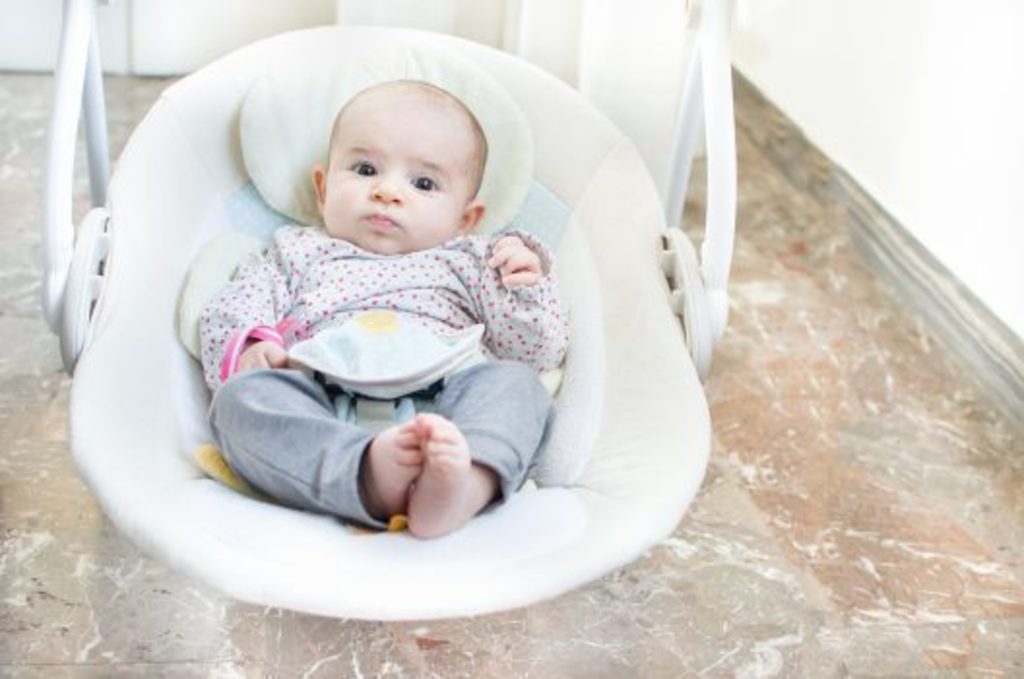Container Babies

What does “container baby” mean?
“Container baby” is a fairly new term used to describe a phenomenon in which young children are spending increasing amounts of time in containers and/or equipment. They are also spending less time experiencing free play, floor time and tummy time. Examples of containers and equipment include:
- Bouncy seats
- Vibrating seats
- Bumbo chair
- Boppy Pillows
- Car seats (outside of car rides)
- Highchairs/feeding positioning systems (outside of meal time)
- Exersaucers
- Walkers
- Jumpers
- Swings
Why are containers used more frequently?
Since the introduction of the Back to Sleep Campaign, it was recommended that babies be placed on their backs for safe sleeping. The Back to Sleep Campaign has had a positive impact on reducing Sudden Infant Death Syndrome, but studies have shown that some parents have started to perceive tummy time as an unsafe position for babies and therefore avoid placing children on their tummies. The American Academy of Pediatrics continues to recommend “back to sleep” but now has added “tummy to play” to advocate that babies should be spending more awake, supervised time on their tummy to enhance development.
How does it impact development?
When babies and toddlers are placed in containers, they are generally fully enclosed and supported by that container, which reduces their ability and motivation to use their own muscles to move. It can impact how much information they are able to receive from their environment both visually and auditorily which can affect their sensory development. Most containers/equipment place the child in a supine (laying on their back), sitting or standing position, so they are spending less time on their tummy, which can further impact sensory integration skills, global strength and coordination that is necessary for babies to meet their gross motor milestones. Using other types of equipment such as walkers, jumpers and swings that do not appear to fully “contain” the child have also been shown to have a negative impact on motor development as they can often promote inappropriate movement patterns. Overall, placing babies in containers and equipment provides them with less time for independent movement and exploration which is crucial for development.
There has also been an increase in the incidence of head flattening (plagiocephaly) and neck muscle tightness (torticollis) that has been linked to increased time spent in containers.
How to enhance motor development:
- Place child on tummy during supervised awake time as much as possible; try after every diaper change to make it part of your family routine. The baby may initially fuss when placed in this position, so you can start for a short period of time and increase the time as baby gets more comfortable.
- Place toys around baby when he is on his tummy and sitting to encourage reaching and moving. Start moving the toys slightly out of his reach to increase the challenge. Always make sure the child has enough room and cushioning (place pillows around him and a blanket under him) so that if he loses his balance he will not hurt himself.
- Play social games with baby (peek-a-boo) and sing songs while moving baby’s arms and legs to the music, change your position to encourage baby to hold up his neck and look in both directions (left and right).
- Remember, frustration is a natural part of learning; try not to rescue the baby right away when he becomes fussy in certain positions or if he can’t reach the toys he wants. Give him a chance to figure it out on his own.
We all have very busy lives and sometimes it is necessary for babies to be in “containers” for their own safety so that parents and caregivers are able to complete tasks, but this should be limited as much as possible to avoid the potential for developmental delays.
References:
- AAP Expands Guidelines for Infant Sleep Safety and SIDS Risk Reduction. (2011).
- Retrieved from https://www.aap.org/en-us/about-the-aap/aap-press-room/pages/AAP-Expands-Guidelines-for-Infant-Sleep-Safety-and-SIDS-Risk-Reduction.aspx?nfstatus=401&nftoken=00000000-0000-0000-0000-000000000000&nfstatusdescription=ERROR:+No+local+token
- Bartlett, D.J., & Kneale Fanning, J.E. (2003). Relationships of Equipment Use and Play
- Positions to Motor Development at Eight Months Corrected Age of Infants Born Preterm. Lippincott Williams & Wilkins, Inc.
- Day, L. (2009). Solitary Confinement. Baby Sensory, 1-8.
- Follert, J. (August 11, 2015). Beware ‘container baby’ syndrome: Durham Expert
- says babies need tummy time, free movement. Retrieved from http://www.durhamregion.com/community-story/5789094-beware-container-baby-syndrome-durham-expert-says-babies-need-tummy-time-free-movement/
- Trawick-Smith, J. The Physical Play and Motor Development of Young children: A
- Review of Literature and Implications for Practice. The Center for Early Childhood Education Eastern Connecticut State University.
PostedBy: Aimee Erb-Jirovec, MS OTR/L
Πρόσφατα Άρθρα

Why Baby’s Sense of Smell is Important
What’s in a Scent?
They say the nose knows. That couldn’t be truer for your newborn. Their sense of smell is not just incredibly strong, but it helps them learn about people and places, ...

Early Detection + Early Intervention = A Life Full of Possibilities
Baby’s early years are some of the most important years for their development, which is why early detection and early intervention are so critical. In the first years of baby’s life, their brain ha...

Baby-Proofing: 14 Tips for Your Home
Baby-Proofing: 14 Tips for Your Home
Your little one is movin’ and cruisin’! So what’s next? Now the challenge is making sure your house is ready for your toddler’s new explorations. Fol...
